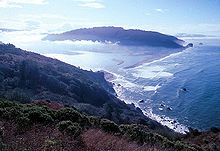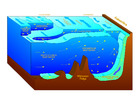- Littoral zone
-
"Littoral" redirects here. For other uses, see Littoral (disambiguation).
Marine habitats 
Different disciplines and agencies divide the littoral zone into different subregions, according to how they want to view the zone. This diagram shows the way the United States Navy views the zone.
Littoral zone Intertidal zone Estuaries Kelp forests Coral reefs Ocean banks Continental shelf Neritic zone Straits Pelagic zone Oceanic zone Seamounts Hydrothermal vents Cold seeps Demersal zone Benthic zone The littoral zone is that part of a sea, lake or river that is close to the shore. In coastal environments the littoral zone extends from the high water mark, which is rarely inundated, to shoreline areas that are permanently submerged. It always includes this intertidal zone and is often used to mean the same as the intertidal zone. However, the meaning of "littoral zone" can extend well beyond the intertidal zone.
There is no single definition. What is regarded as the full extent of the littoral zone, and the way the littoral zone is divided into subregions, varies in different contexts (lakes and rivers have their own definitions). The use of the term also varies from one part of the world to another, and between different disciplines. For example, military commanders speak of the littoral in ways that are quite different from marine biologists.
The adjacency of water gives a number of distinctive characteristics to littoral regions. The erosive power of water results in particular types of landforms, such as sand dunes, and estuaries. The natural movement of the littoral along the coast is called the littoral drift. Biologically, the ready availability of water enables a greater variety of plant and animal life, and the additional local humidity due to evaporation usually creates a microclimate supporting unique types of organisms.
The word "littoral" is used both as a noun and an adjective. It derives from the Latin noun litus, litoris, meaning "shore". (The doubled 't' is a late medieval innovation and the word is sometimes seen in the more classical-looking spelling 'litoral'.)
Contents
In oceanography and marine biology
 The intertidal zone of a beach is part of the littoral zone
The intertidal zone of a beach is part of the littoral zone
In oceanography and marine biology, the idea of the littoral zone is extended roughly to the edge of the continental shelf. Starting from the shoreline, the littoral zone begins at the spray region just above the high tide mark. From here, it moves to the intertidal region between the high and low water marks, and then out as far as the edge of the continental shelf. These three subregions are called, in order, the supralittoral zone, the eulittoral zone and the sublittoral zone.
Supralittoral zone
Main article: Supralittoral zoneThe supralittoral zone (also called the splash, spray, or supratidal zone) is the area above the spring high tide line that is regularly splashed, but not submerged by ocean water. Seawater penetrates these elevated areas only during storms with high tides.
Organisms here must cope also with exposure to bad air, fresh water from rain, cold, heat and predation by land animals and seabirds. At the top of this area, patches of dark lichens can appear as crusts on rocks. Some types of periwinkles, Neritidae and detritus feeding Isopoda commonly inhabit the lower supralitoral.[1]
Eulittoral zone
Main article: Intertidal zoneThe eulittoral zone (also called the midlittoral or mediolittoral zone) is the intertidal zone, also known as the foreshore. It extends from the spring high tide line, which is rarely inundated, to the neap low tide line, which is rarely not inundated. The wave action and turbulence of recurring tides shapes and reforms cliffs, gaps, and caves, offering a huge range of habitats for sedentary organisms. Protected rocky shorelines usually show a narrow almost homogenous eulittoral strip, often marked by the presence of barnacles. Exposed sites show a wider extension and are often divided into further zones. For more on this, see intertidal ecology.
Sublittoral zone
Main article: Neritic zoneThe sublittoral zone, also called the neritic zone, starts immediately below the eulittoral zone. This zone is permanently covered with seawater.
In physical oceanography, the sublittoral zone refers to coastal regions with significant tidal flows and energy dissipation, including non-linear flows, internal waves, river outflows and oceanic fronts. In practice, this typically extends to the edge of the continental shelf, with depths around 200 metres.
In marine biology, the sublittoral refers to the areas where sunlight reaches the ocean floor, that is, where the water is never so deep as to take it out of the photic zone. This results in high primary production and makes the sublittoral zone the location of the majority of sea life. As in physical oceanography, this zone typically extends to the edge of the continental shelf. The benthic zone in the sublittoral is much more stable than in the intertidal zone; temperature, water pressure, and the amount of sunlight remain fairly constant. Sublittoral corals do not have to deal with as much change as intertidal corals. Corals can live in both zones, but they are more common in the sublittoral zone.
Within the sublittoral, marine biologists also identify the following:
- The infralittoral zone is the algal dominated zone to maybe five metres below the low water mark.
- The circalittoral zone is the region beyond the infralittoral, that is, below the algal zone and dominated by sessile animals such as oysters.
Shallower region of the sublittoral zone, extending not far from the shore, are sometimes referred to as the subtidal zone.
Around lakes
In lakes, where tides are usually negligibly small, other definitions of "littoral" are used. For example, the Minnesota Department of Natural Resources defines littoral as that portion of the lake that is less than 15 feet in depth.[2] This zone is home to most of the aquatic plant life (both rooted and floating) in a pond or lake because the high amount of sunlight reaching it allows for significant photosynthetic activity.
Other definitions
For the purposes of naval operations, the United States Navy divides the littoral zone in the ways shown on the diagram at the top of this article. The United States Army Corps of Engineers and Environmental Protection Agency have their own definitions, and these have legal implications.
See also
- Ballantine Scale
- Benthic zone
- Coastal fish
- Intertidal zone
- Foreshore
- Limnetic zone
- Littoral combat ship
- Littoral drift
- Littoral warfare
- Marine debris
- Neritic zone
- Profundal zone
- Shingle beach
Notes
- ^ Yip and Madl
- ^ "Fisheries lake surveys". http://www.dnr.state.mn.us/lakefind/surveys.html#littoral. Retrieved 2006-03-17.
References
- Haslett, Simon K (2001) Coastal Systems. Routledge. ISBN 978-0415213028
- Mann, Kenneth Henry (2000) Ecology of Coastal Waters Blackwell Publishing. ISBN 9780865425507
- Yip, Maricela and Madl, Pierre (1999) Littoral University of Salzburg.
Coastal geography Landforms - Anchialine pool
- Avulsion
- Archipelago
- Atoll
- Ayre
- Barrier bar
- Barrier island
- Bay
- Baymouth bar
- Bight
- Brackish marsh
- Cape
- Channel
- Cliff
- Cliff-top dune
- Coast
- Coastal plain
- Coastal waterfall
- Continental margin
- Continental shelf
- Coral reef
- Cove
- Dune
- Estuary
- Firth
- Fjard
- Freshwater marsh
- Fundus
- Geo
- Gulf
- Headland
- Inlet
- Intertidal wetland
- Island
- Islet
- Isthmus
- Lagoon
- Marine terrace
- Mouth bar
- Raised shorelines
- Machair
- Mega delta
- Mudflat
- Natural arch
- Peninsula
- Reef
- Ria
- River delta
- Salt marsh
- Shore
- Sound
- Stack
- Strait
- Strand plain
- Submarine canyon
- Tied island
- Tidal island
- Tidal marsh
- Tide pool
- Tombolo
- More...


Beaches Processes - Blowhole
- Coastal erosion
- Concordant coastline
- Current
- Cuspate foreland
- Discordant coastline
- Emergent coastline
- Feeder bluff
- Fetch
- Headlands and bays
- Large scale coastal behaviour
- Longshore drift
- Marine regression
- Marine transgression
- Rip current
- Sea cave
- Sea foam
- Shoal
- Spit
- Submergent coastline
- Surf break
- Surf zone
- Surge channel
- Swash
- Volcanic arc
- Wave-cut platform
- Wave shoaling
- Wind wave
- Wrack zone
Management Related Categories:- Aquatic biomes
- Marine biology
- Fisheries
- Aquatic ecology
Wikimedia Foundation. 2010.




